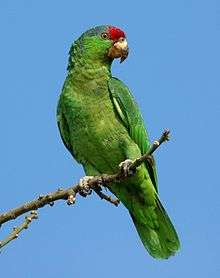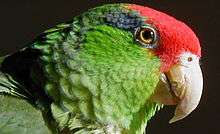Red-crowned amazon
| Red-crowned Amazon | |
|---|---|
 | |
| Scientific classification | |
| Kingdom: | Animalia |
| Phylum: | Chordata |
| Class: | Aves |
| Order: | Psittaciformes |
| Family: | Psittacidae |
| Genus: | Amazona |
| Species: | A. viridigenalis |
| Binomial name | |
| Amazona viridigenalis (Cassin, 1853) | |
The red-crowned amazon, (Amazona viridigenalis) also known as red-crowned parrot, green-cheeked amazon, or Mexican red-headed parrot, is a highly social, endangered amazon parrot native to northeastern Mexico. The current native wild population of between 1,000 and 2,000 is decreasing. The main threats to the native bird's survival are the illegal export of trapped birds from Mexico to the United States for the pet trade and the destruction of their natural habitat, lowland forests of Northeastern Mexico.[2]
Description

Their appearance is generally green with the most notable features being a bright red forehead and crown, dark blue streak behind the eyes, and light green cheeks. It is not uncommon for Red-crowned Amazons to have splashes of red and blue under their wings and have light yellow-tipped tails.[3] They have a white eye-ring which brings out their eyes. Their iris color can range from a bright yellow to a deep red, although juveniles' eyes are gray until maturity. Red-crowned amazons usually have horn colored beaks and ceres but these can sometimes have black highlights. Their legs are flesh-colored or gray. They are approximately 11-13 inches in length from the beak to the tip of the tail feathers with a wingspan of 15-16 inches. Amazon parrots are not sexually dimorphic, so the only true way to know a parrot's sex is by genetic testing. Their average weight is 270g.[4]
Range
Their natural range is across the lowlands of northeastern Mexico. Feral birds have bred in urban communities of Southern California, Southern Florida, and the island of Oahu in Hawaii. Birds in South Texas may be either feral, descendants of natural vagrants from Mexico, or both. There are roughly 625 feral parrots that can be found in Texas alone. The numbers of wild parrots in the U.S. may rival the natural wild population from Mexico due to their adaptation to urban life.[5] Red-crowned amazons are a resident (non-migratory) species in their native range, but they can wander outside of their breeding range to follow a food source.
Behavior
They gather in large flocks being noisiest in the morning and evening. The characteristic screeching heard of these birds usually occurs when they travel in a large flock to a new feeding area. Their diet consists of seeds, fruits, flowers and nectar. Red-crowned amazons nest in tree cavities, like most other parrots. Amazons are one of the easiest parrots to read the behavior of, as their eye color shows their pinning exceptionally well. Red-crowned amazons pin their eyes when they are excited, either positively or negatively, about something in their environment. It is easy to make out the dilations of the pupil against the bright iris. This pinning combined with different behavioral signs can let a fellow parrot or an owner know how their parrot is feeling. An angry parrot may fan its tail feathers while a content, affectionate parrot may purr, or bend their head down to be scratched.[6]
Aviculture
These parrots are often kept as pets and can be very affectionate and playful when given the attention they need from their owners. Although some are excellent talkers and copy voices, they are best at mimicking sounds that stand out to them, such as the microwave, telephone, or other pets. Many owners report a streak of mischief due to their heightened curiosity. Red-crowned amazons can live 50+ years in captivity, with some extending over 75 years old if properly cared for.
Common challenges associated with owning this type of parrot includes being able to provide enough exercise for it, and convincing it to eat a varied, healthy diet, close to the diet it would have in the wild. Amazons are known for becoming sedentary if not provided enough stimuli, and this can lead to health issues such as obesity. These birds are not regarded as overly sensitive and are actually one of the hardier large species to own as a pet because common stressors for other companion parrot species are coped with better, and neurotic behaviors due to stress or depression, such as feather plucking, are infrequent when compared to other species. Another challenge some owners face is the hormonal bluffing during the breeding season (spring) for adolescents that causes some parrots, especially males, to be more prone to nipping their owners, biting anyone who isn't their favorite person, and screaming. These hormonal outbursts decrease with age.[7]
Reproduction
Red-crowned amazon parrots reach sexual maturity at about five years old. It takes the female approximately 28 days to incubate her eggs, at an average of four eggs per clutch.[8] Fledging begins at nine weeks old. In the wild, these parrots mate for life and find tree cavities near other members of their flock, creating a breeding group known as a colony.[9] They will return to the same cavity every year to raise chicks unless that cavity was previously poached or they did not have reproductive success there for a different reason.
References
- ↑ BirdLife International (2013). "Amazona viridigenalis". IUCN Red List of Threatened Species. Version 2013.2. International Union for Conservation of Nature. Retrieved 26 November 2013.
- ↑ "Red-crowned Parrot". American Bird Conservancy. Retrieved 25 February 2018.
- ↑ "Red-crowned Parrot". Audubon.org. Retrieved 25 February 2018.
- ↑ "Green-cheeked Amazon". Parrots.org. Retrieved 25 February 2018.
- ↑ "Red-Crowned Parrot". American Bird Conservancy. Retrieved 25 February 2018.
- ↑ Saydak, Dennis. "Understanding Amazon Behavior". The Amazona Society. Retrieved 25 February 2018.
- ↑ Kalhagen, Alyson. "Green-cheeked Amazon Parrots". The Spruce. Retrieved 25 February 2018.
- ↑ "Red-crowned Amazon". Bird Guide. Retrieved 25 February 2018.
- ↑ "Green-cheeked Amazon". World Parrot Trust. Retrieved 25 February 2018.
External links
| Wikimedia Commons has media related to the red-crowned amazon. |
- Species factsheet - BirdLife International
- Red-crowned parrot in Texas
- California Parrot Project
